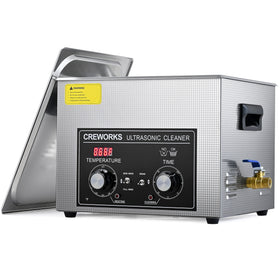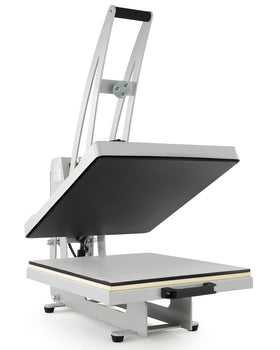Ultrasonic cleaner rust removal isn't just marketing hype. It's actually one of the most effective ways to restore your tools without spending hours scrubbing with steel wool or dealing with harsh chemicals.
Creworks ultrasonic cleaners, for example, come with 304 stainless steel tanks that won't react with rust-removal solutions, industrial-grade transducers for consistent cavitation, and promise quiet operation under 60 dB.
The science behind it is pretty brilliant, and once you understand how this technology works, you'll wonder why you ever bothered with the old-fashioned ways.
Why Ultrasonic Cleaners Work on Rusty Tools
Let's get straight to the science behind why ultrasonic cleaner rust removal is so effective. Here's what's actually happening when you drop your rusty tools into an ultrasonic cleaner.
- The machine generates high-frequency sound waves - typically around 40 kHz - that create billions of microscopic vacuum bubbles in the cleaning solution.
- These bubbles implode with tremendous force when they contact your tools. Think of it like having millions of tiny explosions happening 40,000 times per second, all focused on blasting away rust particles.
- These cavitation bubbles are so small that they can penetrate into every crevice, thread, and tight spot that your wire brush could never reach.
- When you combine it with the right rust-removing solution, you're getting both chemical and physical cleaning happening simultaneously.
- The sound waves speed up the chemical reaction while physically scrubbing away loosened rust particles. Plus, most ultrasonic cleaners come with heating elements.
- Heat accelerates chemical reactions, so that the rust-dissolving solution works faster and more effectively.
How to Use an Ultrasonic Cleaner to Remove Rust From Tools
Now let's get into the actual process of how to remove rust from tools using your ultrasonic cleaner. This method works whether you're dealing with rusty hand tools or larger equipment.
Step 1: Prepare Your Tools and Cleaner
- Before you start, remove any loose debris, dirt, or grease from your tools.
- While ultrasonic cleaners are amazing, they work best when focused on rust removal rather than fighting through layers of grime.
- Set up your ultrasonic cleaner on a stable, flat surface in a well-ventilated area and plug it in.
Step 2: Choose Your Rust-Removal Solution
This is where many people get it wrong. Plain water won't remove rust from tools effectively. You need a solution that chemically attacks the rust while the ultrasonic action does the physical work.
Here are 3 chemical solutions that work for ultrasonic cleaners for rust removal
- Citric Acid Solution: Mix 1-2 tablespoons of citric acid powder per liter of water. This is gentle, non-toxic, and excellent for light to moderate rust.
-
Commercial Rust Removers: Products like the Creworks Heavy Duty Rust Remover work excellently in ultrasonic cleaners and are specifically formulated to dissolve rust without attacking the base metal.
- CLR (Calcium, Lime & Rust): Many users swear by CLR in their ultrasonic cleaners for small rusty parts.
Step 3: Fill and Set Your Cleaner
-
Fill your ultrasonic cleaner tank with your chosen solution, making sure it covers your tools completely.
- Set the temperature to around 100-120°F (40-50°C) for most rust removal solutions.
- Higher temperatures can speed up the process, but check your solution's recommendations first.
Step 4: Load and Run Your Tools
Place your tools in the basket, making sure they're fully submerged but not touching each other if possible.
- Tools can create "dead zones" when they’re in contact, making the ultrasonic action less effective.
- Start with a 10-20 minute cycle for most conditions.
- You can watch rust particles floating away from your tools as the process works its magic.
Step 5: Rinse, Dry, and Protect
After cleaning, remove your tools and rinse them thoroughly with clean water to remove any remaining cleaning solution and loose rust particles.
- Dry them immediately and completely, as wet tools will start rusting again within minutes.
- Apply a rust preventative like WD-40 or light oil while the tools are still warm from the cleaning process.
What Kind of Tools Work Best for Ultrasonic Cleaning
Not all tools respond equally to ultrasonic cleaner rust removal. Some respond perfectly, while others need some special consideration.
Best Tools For Ultrasonic Rust Removal
- Hand tools with complex shapes: adjustable wrenches, socket sets, calipers, and similar tools with cracks, crevices, and pivot points are ideal.
- Small precision tools like drill bits, taps, dies, and measurement tools. An ultrasonic cleaner restores their precision edges without damaging the surfaces.
- Vintage and antique tools, like stamps, markings, or delicate details. An ultrasonic cleaner removes decades of rust without damaging them.
Tools That Need Special Consideration
- Large tools. Obviously, anything bigger than your ultrasonic tank won't fit. But you can often clean components separately.
- If your tool has rubber gaskets, plastic components, or soft metals, check your cleaning solution compatibility first.
- Severely Pitted Tools: While ultrasonic cleaning excels at rust removal, it can't repair physical damage. Deep pitting will be cleaned but not filled.
Best Ultrasonic Cleaners for Tool Rust Removal
You need the right equipment for effective ultrasonic cleaner rust removal. Here are our top recommendations from Creworks:
1. Creworks 240W Professional 10L Ultrasonic Cleaner - $159.99
This is our top pick for serious tool restoration. The 240W of ultrasonic power combined with 300W heating capability provides the muscle needed for effective rust removal.
- The 10-liter capacity can handle most hand tools,
- The 40 kHz frequency provides the right balance of cleaning power and gentleness.
- The 7-level intensity adjustment for right cleaning power for different rust conditions.
- The degas mode removes air bubbles from your cleaning solution, making cavitation more effective.
- Digital controls allow precise temperature settings (68-176°F) and cleaning times up to 30 minutes.
2. Creworks 240W Elongated Design - $149.99
For longer tools, this elongated design can fit items that simply won't fit in standard square tanks. It has the same 240W power and 300W heating as the standard model, but the unique shape is perfect for socket extensions, rulers, or narrow parts.
3. Creworks 480W Heavy-Duty 22L - $219.99
For serious tool collectors or professional shops, this beast delivers 480W of ultrasonic power in a 22-liter tank with 600W heating. The dual knob controls are simple and reliable - perfect for shop environments.
Conclusion
Ultrasonic cleaner rust removal isn't magic - it's science. The combination of cavitation action, chemical cleaning, and controlled heat creates results that you simply can't match manually.
Whether you're dealing with light surface rust or decades of corrosion, ultrasonic cleaning can restore your tools to like-new condition.
With the right Creworks ultrasonic cleaner and proper technique, you can transform your rusty tool collection back into pristine, functional ones that will serve you for years to come.
My name is Michael Anderson, and I am a senior engineer specializing in heavy machinery and equipment. I hold a degree in mechanical engineering and have extensive experience in mining and construction industries worldwide. My aim is to simplify complex technical concepts, making them accessible and understandable to a wide audience.














Leave a comment